
Gas fireplaces are a modern convenience, offering warmth and ambiance without the hassle of traditional wood-burning setups. But just because they’re low-maintenance doesn’t mean they’re no-maintenance.
Over time, dust, debris, and even soot can build up, reducing efficiency and potentially posing a safety hazard.
Regular cleaning ensures your fireplace not only looks great but runs smoothly and safely.
If you’ve ever wondered, “Do gas fireplaces really need to be cleaned?” the answer is a loud and clear, “Hell, yes!” Let’s break down why it’s essential and, more importantly, how to do it right.

Image by galle_construction
Melissa Maker (Clean My Space):
“Even though gas fireplaces don’t produce the same level of soot as wood-burning ones, it’s crucial to clean them regularly. Dust, debris, and even residue can build up, reducing efficiency and potentially causing hazards like gas leaks.”
How Often Should You Clean a Gas Fireplace?
A gas fireplace should typically be cleaned at least once a year, ideally before the start of the colder months when it sees more use.
Regular cleaning helps ensure it operates safely and efficiently, preventing the buildup of dust, debris, or soot.
However, if you use your gas fireplace frequently, you might want to consider inspecting it more often, about every few months, to clear out any visible dust or grime from the glass, logs, and vents.
Additionally, an annual inspection by a professional is highly recommended to ensure the fireplace’s components, like the burner and ventilation system, are in good working order.
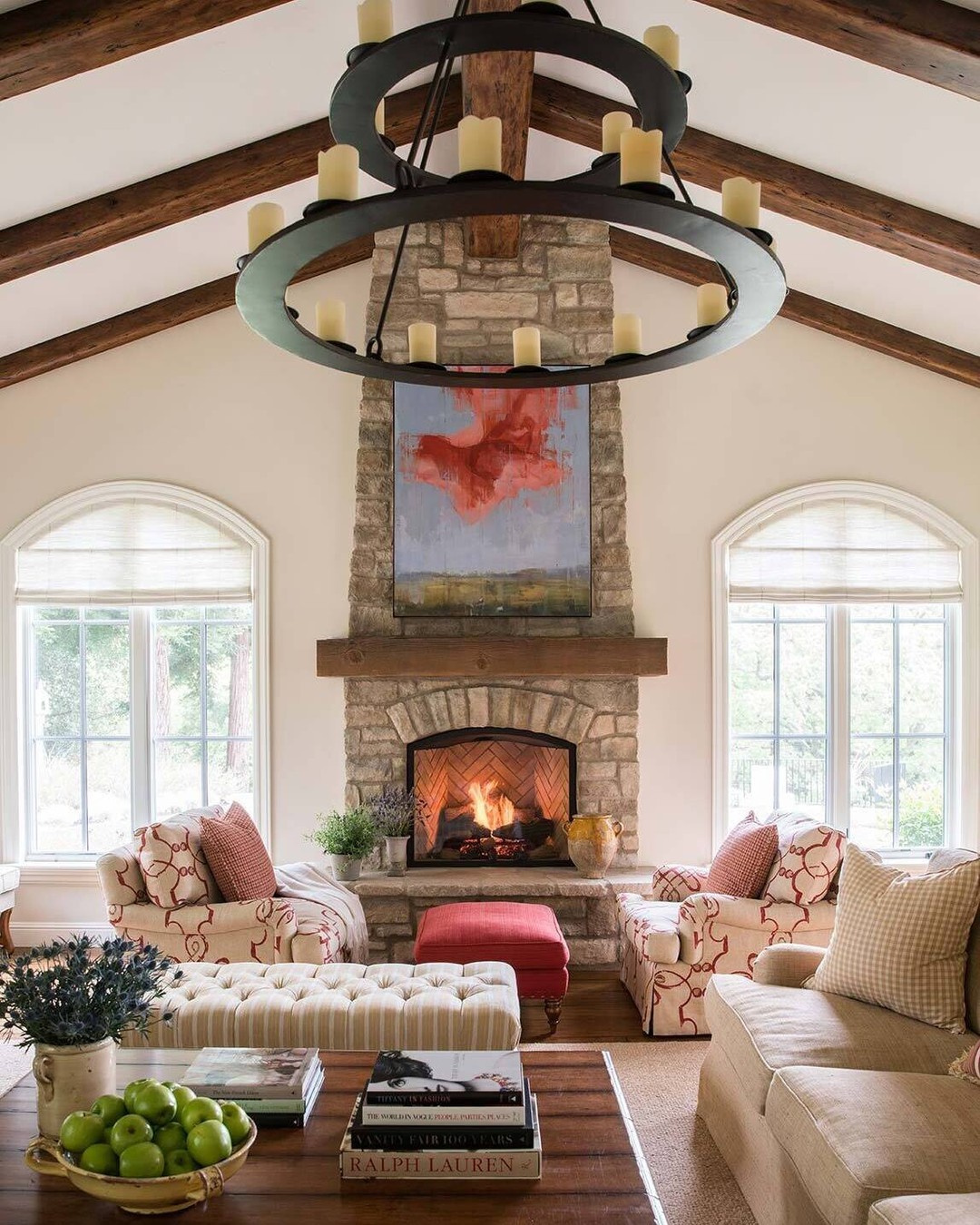
Image by kristemichelini
Becky Rapinchuk (Clean Mama) explains, “It’s important to clean your gas fireplace at least once a year to ensure it’s running efficiently and safely. Dust and debris can build up, impacting performance. If you use it heavily, consider giving it a check every few months.”
Read – 25 Beautiful Fall Fireplace Decor Ideas You Must Try
Things You’ll Need:
To clean your gas fireplace properly, gather the following tools and materials:
- Soft-bristle brush – For gently dusting logs, burners, and other components.
- Microfiber cloth – For wiping down the glass and exterior surfaces.
Julie Blanner from Julie Blanner recommends using a microfiber cloth to clean the fireplace’s exterior and interior. For stubborn dirt on the glass, she suggests a mix of water and vinegar for a streak-free shine.
- Vacuum cleaner with a hose attachment – For cleaning dust and debris inside the firebox and around the burner.
- Glass cleaner (non-ammonia) – For cleaning the fireplace glass without damaging it.
- Mild soap and water – For cleaning any soot or grime from the firebox or exterior areas.
- Compressed air can – For blowing out dust from small vents or tight spaces.
- Screwdriver – To remove the glass panel or access certain components, if needed.
- Leather gloves – To protect your hands while handling fireplace components, especially the glass.
- Drop cloth or old towel – To protect the floor from dirt or debris during cleaning.
These items will help you thoroughly clean the fireplace without damaging any of its components.
 Image by lauren_nelson_design
Image by lauren_nelson_design
Read – 25 Dining Room With Fireplace Ideas You Should See
How To Clean A Gas Fireplace?
1. Turn Off the Gas and Wait for Everything to Cool
Safety should always come first. Make sure the gas is completely off before starting, and give the fireplace plenty of time to cool down. Even if the glass feels cool, the internal parts can still be warm, and you definitely don’t want to risk injury or mess with any gas lines while things are still hot. Safety isn’t just about turning off the gas; it’s about giving it time to settle.
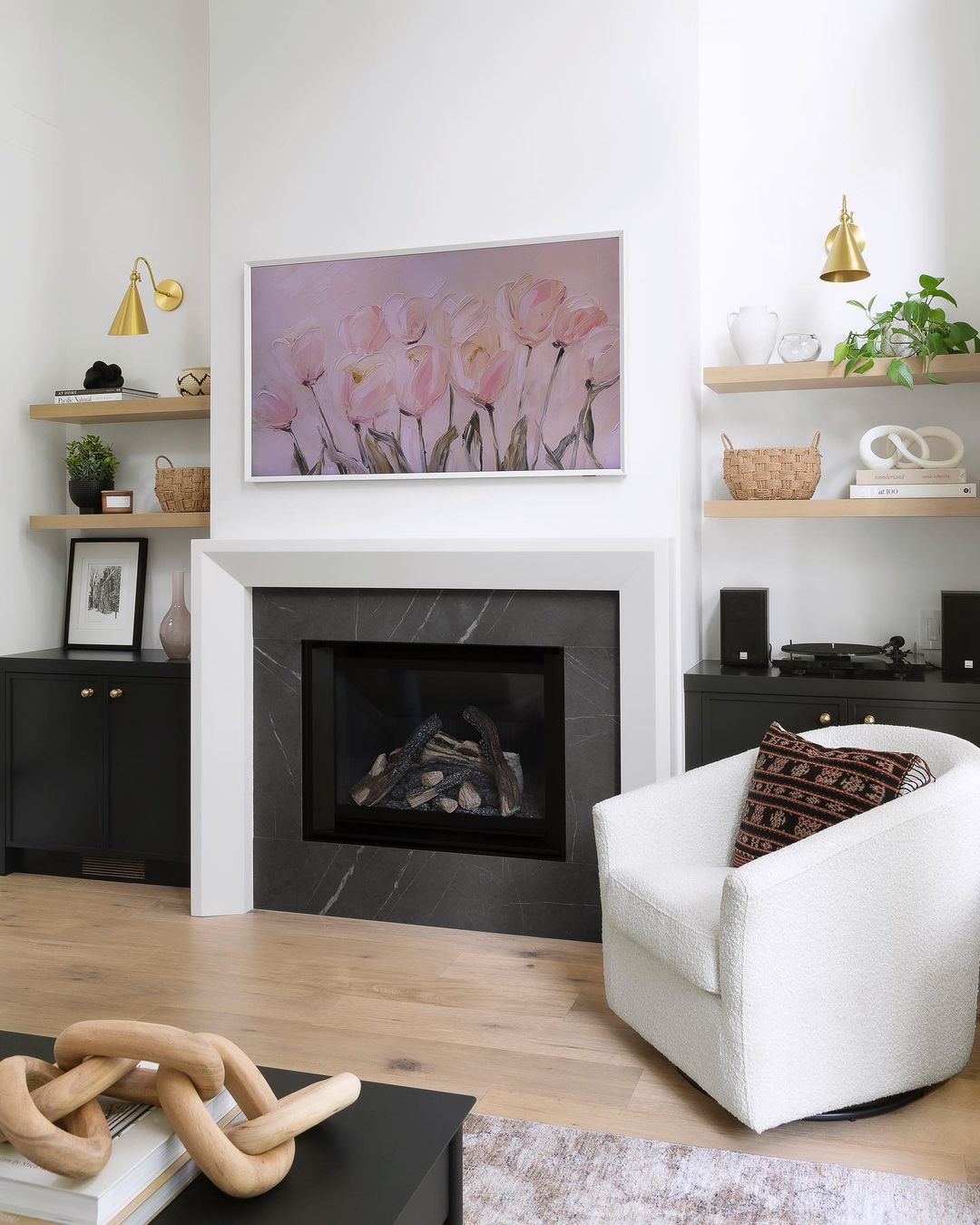 Image by gisellehoward_interiors
Image by gisellehoward_interiors
Melissa Maker from Clean My Space advises starting with safety by ensuring the gas is off and the fireplace has fully cooled before beginning any cleaning process. She emphasizes the importance of regularly cleaning the glass to avoid soot buildup, which can reduce visibility and efficiency.
Read – 30 Cozy Fireplace Seating Ideas You Should Have a Look At
2. Remove the Glass Panel Gently
The glass panel is the gateway to your fireplace, but it’s also pretty fragile. Removing it carefully will ensure you don’t damage it, and placing it on a soft towel keeps it scratch-free.
Glass buildup is more than just a visual issue—dirt and soot can actually impact how much heat gets distributed into your room, so keeping this clean is a must for both aesthetics and function.
 Image by formandfield
Image by formandfield
3. Inspect for Soot or Residue
Soot is more than just dirty—it’s a sign of how your fireplace is running. A small amount of soot is normal, but if you’re seeing a lot, it’s a signal that something’s not quite right, whether it’s poor combustion or airflow issues.
This is an early warning sign that things might need adjustment before they get worse, so don’t ignore it. Think of it as your fireplace’s way of asking for a little extra care.
 Image by verandaestatehomes
Image by verandaestatehomes
Read – 25 Dramatic And Colorful Painted Fireplace Ideas You Will Love
4. Clean the Glass the Right Way
Cleaning your glass with a non-ammonia-based cleaner isn’t just about avoiding streaks—it’s about protecting the glass itself. Ammonia can cause damage to the fireplace glass over time, creating a foggy effect that’s permanent. Use gentle cleaners or a water-vinegar solution for a deeper clean. Keeping this glass clean doesn’t just make it look better; it ensures you’re getting the full visual effect and helps the fireplace run more efficiently by maintaining a clear barrier.
 Image by ourvictorianhome_66
Image by ourvictorianhome_66
Becky Rapinchuk from Clean Mama recommends using non-toxic cleaning products, especially on delicate components like the glass panel. She also stresses the importance of regular vacuuming to remove dust and debris that may clog the burner or pilot light.
5. Dust the Logs and Keep Them in Place
Those ceramic logs aren’t just for show—they’re placed in a specific pattern to ensure proper airflow and combustion. If you accidentally move them, it can disrupt the fireplace’s efficiency and even cause safety issues like improper gas combustion.
Gently dust them with a soft brush, and always put them back in their original position if they shift. It’s a small step that makes a big difference in how your fireplace performs.
 Image by newbzresidence_no7
Image by newbzresidence_no7
Dana K. White from A Slob Comes Clean suggests inspecting the ceramic logs carefully. She highlights that while they don’t need frequent cleaning, when you do, gently dust them without moving them from their original positions to ensure efficient burning
6. Vacuum the Firebox and Burner
Dust in the firebox or around the burner may not seem like a big deal, but it can clog the burner ports, making it harder for your fireplace to ignite and run efficiently.
Use a vacuum with a hose attachment to remove all the dust and debris. This step is crucial for maintaining even flame distribution and preventing any clogging in the burner, which can lead to bigger problems later.
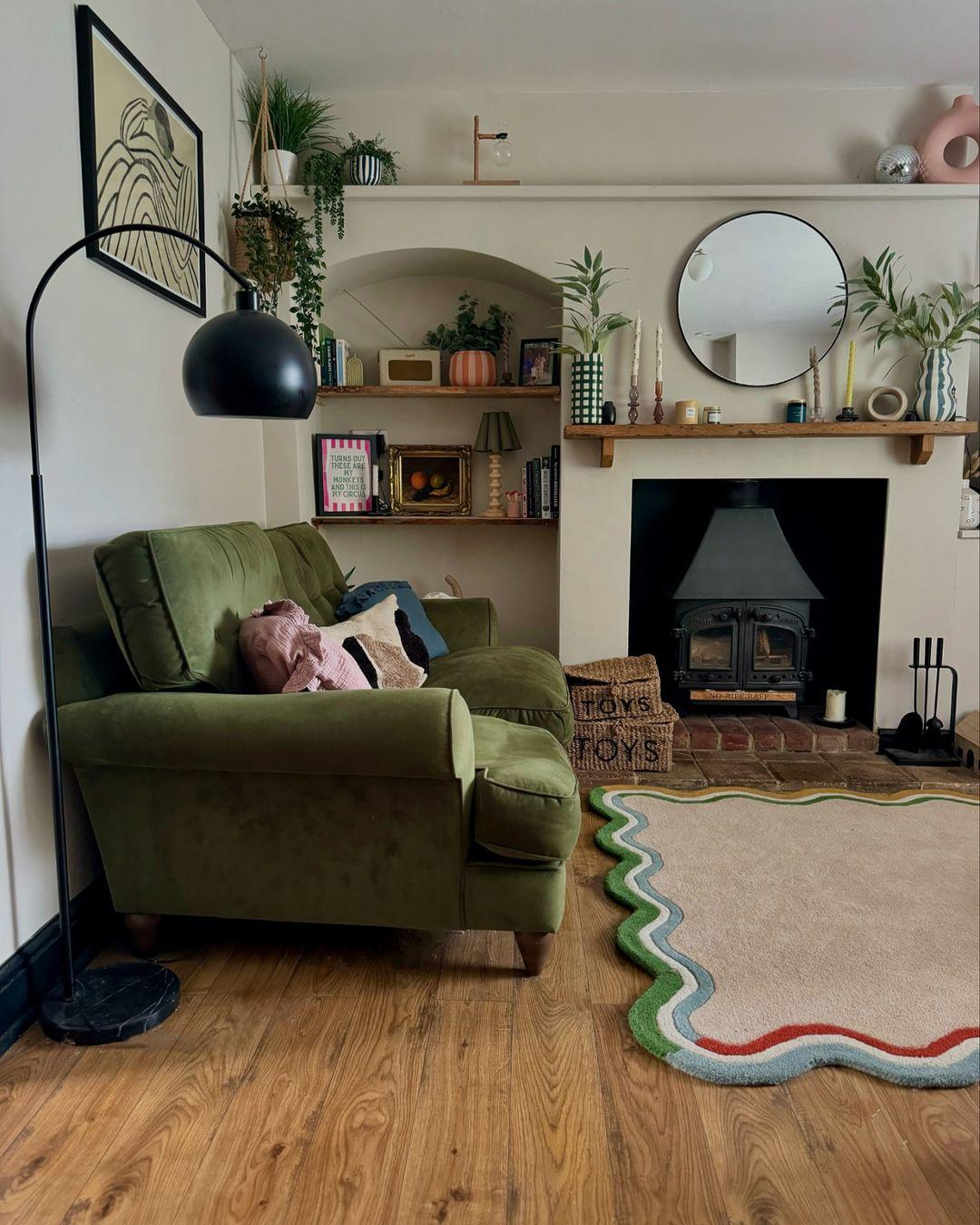 Image by thegreenwoldgaff
Image by thegreenwoldgaff
Jillee from One Good Thing by Jillee advises vacuuming around the burner and vent areas to clear dust and improve air circulation.
Read – 25 Most Beautiful And Lovely Coastal fireplace Ideas You Will Love
7. Check and Clean the Burner Ports and Pilot Light
Dust can easily gather around the burner ports and pilot light, and that can affect how well the gas flows and ignites. A little blast of compressed air can help clear it out. This is one of those small tasks that people often overlook, but it’s critical to the overall performance of your fireplace.
A dirty pilot light or burner means uneven flames, and nobody wants a fireplace that doesn’t light consistently when you need it most.
 Image by homeonthehey
Image by homeonthehey
8. Inspect the Venting System
Your fireplace’s venting system is like its lungs. If it’s blocked or obstructed, it won’t be able to “breathe” properly, leading to poor performance and, in some cases, dangerous carbon monoxide buildup.
Go outside and check the vent cap for leaves, snow, or other blockages. Proper venting ensures not only the fireplace’s efficiency but your safety as well. A blocked vent could mean that harmful gases, like carbon monoxide, are staying inside your home.
 Image by parrismckennadesign
Image by parrismckennadesign
Katie Berry from Housewife How-Tos advises checking the ventilation system during routine cleaning. A blocked vent can lead to dangerous carbon monoxide buildup, so she recommends inspecting the external vent for any obstructions like leaves or snow.
9. Clean the Exterior for Longevity
Wiping down the exterior isn’t just about keeping things looking nice—it’s also a way to protect the materials around your fireplace. Dust, grime, and fingerprints can wear down the finish over time.
Using mild soap and water ensures that you’re not stripping any protective coatings or scratching the surface. A clean exterior keeps your fireplace looking new and prevents long-term damage.

Image by houseliftdesign
Read – 15 Rustic And Timeless Candles In Fireplace Ideas You Will Love
10. Reassemble and Test It
Once you’ve cleaned everything, carefully put the logs and glass back in place. This isn’t just about looks—it’s about making sure your fireplace is ready to perform its best. Turn the gas back on and test the flames.
If you see flickering, uneven flames, or hear strange noises, those are early signs something might need further inspection. Testing the fireplace after cleaning ensures everything is working correctly before the colder months hit.
 Image by mmlighting
Image by mmlighting
11. Regular Professional Maintenance
While regular DIY cleaning is important, having a professional check your fireplace annually is a smart move. They can inspect things you might not notice, like gas leaks or wear on critical components.
An expert can also make any necessary adjustments to ensure everything runs safely and efficiently. Think of it as an annual health check-up for your fireplace, making sure it’s in top shape for the long run.
 Image by sunnycirclestudio
Image by sunnycirclestudio
Read – 25 Beautiful Limewash Brick Fireplace Ideas You Will Love
Extra Insights:
- Keep an eye on unusual smells: If you notice any odd odors, especially gas, turn off the fireplace and get it inspected right away. Strange smells can indicate a potential problem with the gas line or venting system.
- Carbon monoxide detectors are a must: Gas fireplaces, though efficient, can pose a risk if they aren’t venting properly. Installing a carbon monoxide detector near the fireplace ensures you catch any issues early.
- Cleaning regularly saves you money: Regular cleaning not only keeps your fireplace looking great but can also prevent costly repairs down the road. A clean, well-maintained fireplace runs more efficiently, using less gas and putting out more heat.
 Image by serenaandlily
Image by serenaandlily
Read – 30 Cozy Brick Fireplace Mantle Ideas You Will Love
By taking these steps, you’re not just cleaning your fireplace—you’re investing in its long-term performance and safety. Regular maintenance means fewer problems later, and when winter comes, you’ll be able to enjoy the warmth without any worries.
Do Gas Fireplaces Need To Be Cleaned? Hell, Yes! And Here’s How.
Gas fireplaces are a modern convenience, offering warmth and ambiance without the hassle of traditional wood-burning setups. But just because they’re low-maintenance doesn’t mean they’re no-maintenance.
Over time, dust, debris, and even soot can build up, reducing efficiency and potentially posing a safety hazard.
Regular cleaning ensures your fireplace not only looks great but runs smoothly and safely.
If you’ve ever wondered, “Do gas fireplaces really need to be cleaned?” the answer is a loud and clear, “Hell, yes!” Let’s break down why it’s essential and, more importantly, how to do it right.

Image by galle_construction
Melissa Maker (Clean My Space):
“Even though gas fireplaces don’t produce the same level of soot as wood-burning ones, it’s crucial to clean them regularly. Dust, debris, and even residue can build up, reducing efficiency and potentially causing hazards like gas leaks.”
How Often Should You Clean a Gas Fireplace?
A gas fireplace should typically be cleaned at least once a year, ideally before the start of the colder months when it sees more use.
Regular cleaning helps ensure it operates safely and efficiently, preventing the buildup of dust, debris, or soot.
However, if you use your gas fireplace frequently, you might want to consider inspecting it more often, about every few months, to clear out any visible dust or grime from the glass, logs, and vents.
Additionally, an annual inspection by a professional is highly recommended to ensure the fireplace’s components, like the burner and ventilation system, are in good working order.
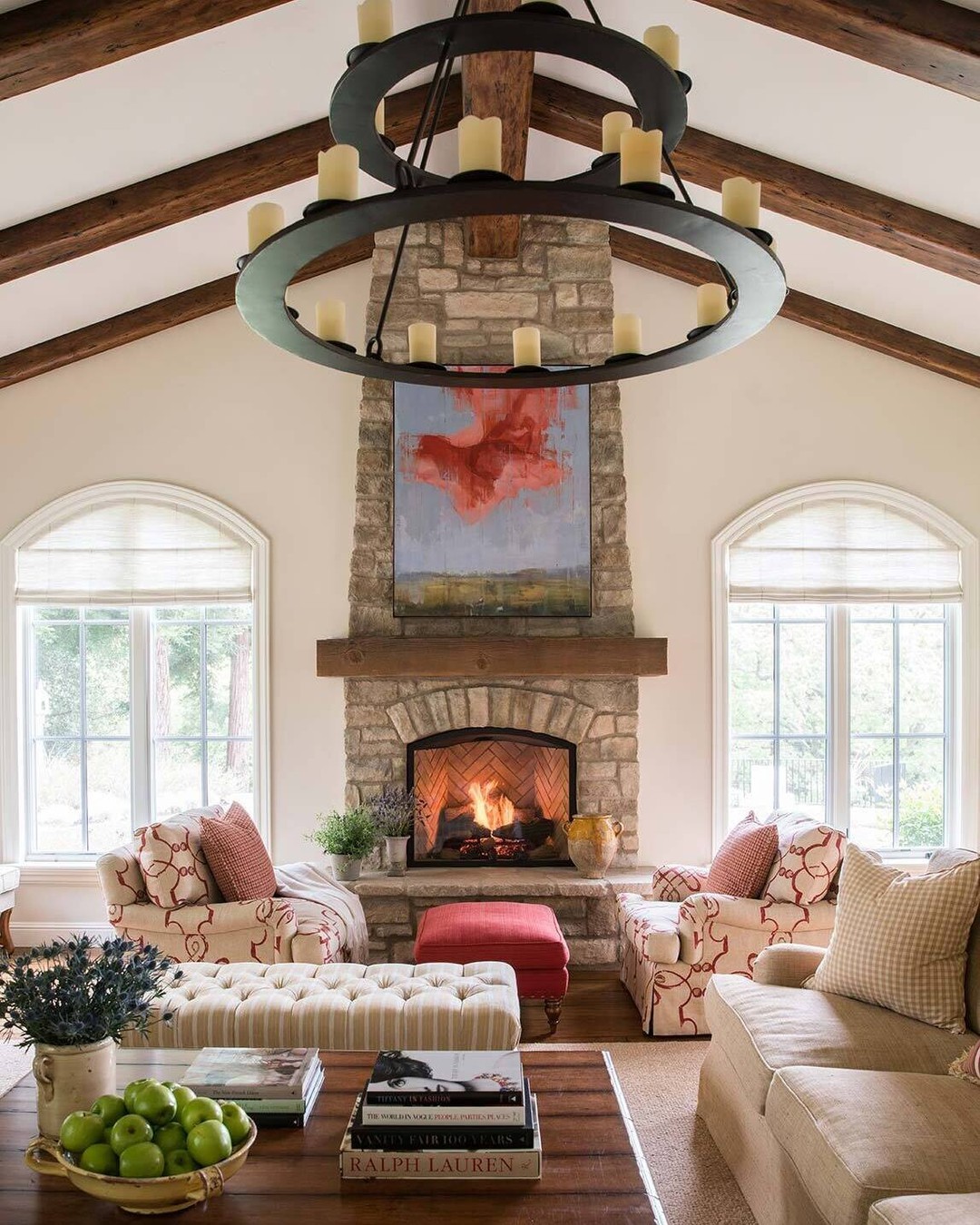
Image by kristemichelini
Becky Rapinchuk (Clean Mama) explains, “It’s important to clean your gas fireplace at least once a year to ensure it’s running efficiently and safely. Dust and debris can build up, impacting performance. If you use it heavily, consider giving it a check every few months.”
Read – 25 Beautiful Fall Fireplace Decor Ideas You Must Try
Things You’ll Need:
To clean your gas fireplace properly, gather the following tools and materials:
- Soft-bristle brush – For gently dusting logs, burners, and other components.
- Microfiber cloth – For wiping down the glass and exterior surfaces.
Julie Blanner from Julie Blanner recommends using a microfiber cloth to clean the fireplace’s exterior and interior. For stubborn dirt on the glass, she suggests a mix of water and vinegar for a streak-free shine.
- Vacuum cleaner with a hose attachment – For cleaning dust and debris inside the firebox and around the burner.
- Glass cleaner (non-ammonia) – For cleaning the fireplace glass without damaging it.
- Mild soap and water – For cleaning any soot or grime from the firebox or exterior areas.
- Compressed air can – For blowing out dust from small vents or tight spaces.
- Screwdriver – To remove the glass panel or access certain components, if needed.
- Leather gloves – To protect your hands while handling fireplace components, especially the glass.
- Drop cloth or old towel – To protect the floor from dirt or debris during cleaning.
These items will help you thoroughly clean the fireplace without damaging any of its components.
 Image by lauren_nelson_design
Image by lauren_nelson_design
Read – 25 Dining Room With Fireplace Ideas You Should See
How To Clean A Gas Fireplace?
1. Turn Off the Gas and Wait for Everything to Cool
Safety should always come first. Make sure the gas is completely off before starting, and give the fireplace plenty of time to cool down. Even if the glass feels cool, the internal parts can still be warm, and you definitely don’t want to risk injury or mess with any gas lines while things are still hot. Safety isn’t just about turning off the gas; it’s about giving it time to settle.
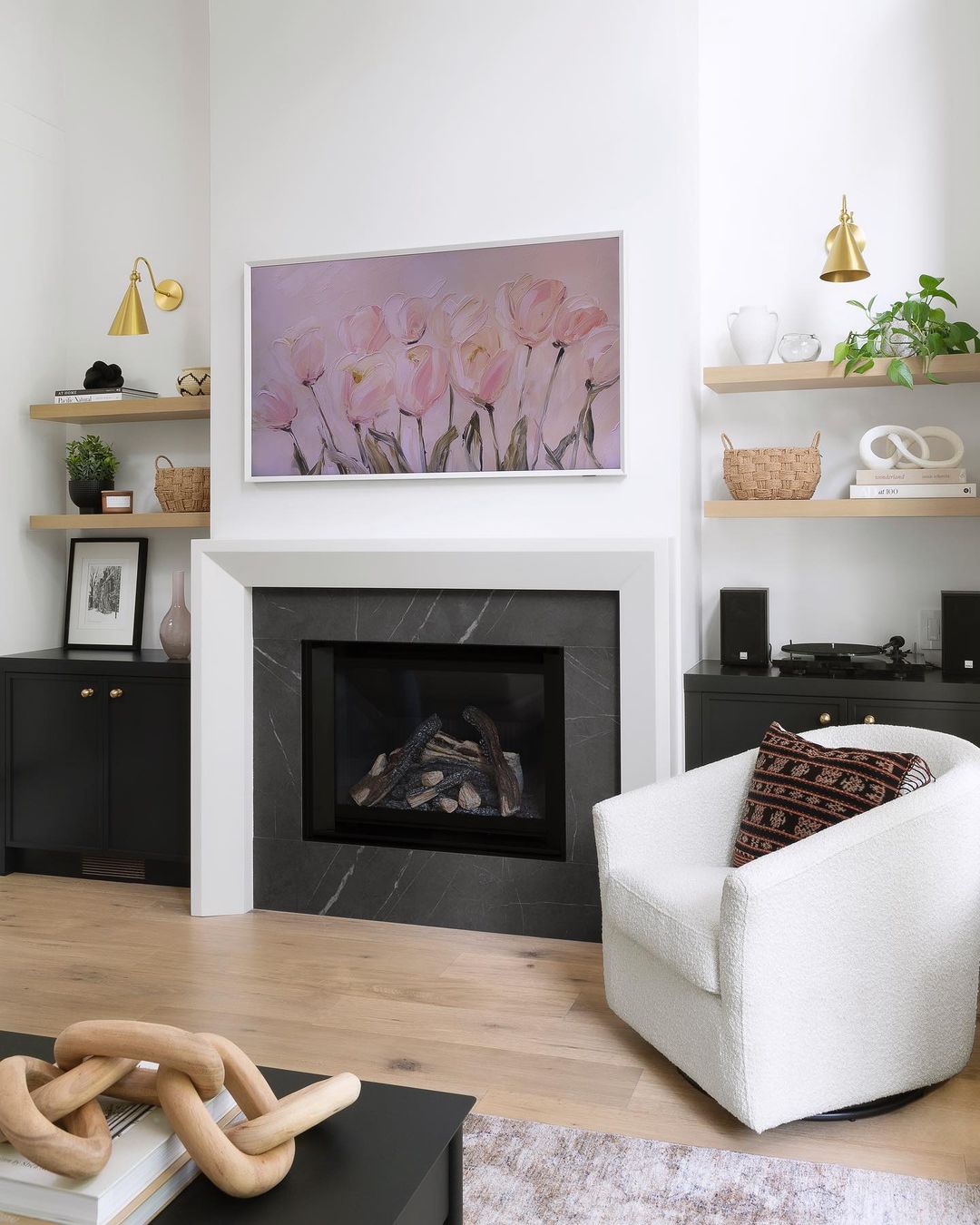 Image by gisellehoward_interiors
Image by gisellehoward_interiors
Melissa Maker from Clean My Space advises starting with safety by ensuring the gas is off and the fireplace has fully cooled before beginning any cleaning process. She emphasizes the importance of regularly cleaning the glass to avoid soot buildup, which can reduce visibility and efficiency.
Read – 30 Cozy Fireplace Seating Ideas You Should Have a Look At
2. Remove the Glass Panel Gently
The glass panel is the gateway to your fireplace, but it’s also pretty fragile. Removing it carefully will ensure you don’t damage it, and placing it on a soft towel keeps it scratch-free.
Glass buildup is more than just a visual issue—dirt and soot can actually impact how much heat gets distributed into your room, so keeping this clean is a must for both aesthetics and function.
 Image by formandfield
Image by formandfield
3. Inspect for Soot or Residue
Soot is more than just dirty—it’s a sign of how your fireplace is running. A small amount of soot is normal, but if you’re seeing a lot, it’s a signal that something’s not quite right, whether it’s poor combustion or airflow issues.
This is an early warning sign that things might need adjustment before they get worse, so don’t ignore it. Think of it as your fireplace’s way of asking for a little extra care.
 Image by verandaestatehomes
Image by verandaestatehomes
Read – 25 Dramatic And Colorful Painted Fireplace Ideas You Will Love
4. Clean the Glass the Right Way
Cleaning your glass with a non-ammonia-based cleaner isn’t just about avoiding streaks—it’s about protecting the glass itself. Ammonia can cause damage to the fireplace glass over time, creating a foggy effect that’s permanent. Use gentle cleaners or a water-vinegar solution for a deeper clean. Keeping this glass clean doesn’t just make it look better; it ensures you’re getting the full visual effect and helps the fireplace run more efficiently by maintaining a clear barrier.
 Image by ourvictorianhome_66
Image by ourvictorianhome_66
Becky Rapinchuk from Clean Mama recommends using non-toxic cleaning products, especially on delicate components like the glass panel. She also stresses the importance of regular vacuuming to remove dust and debris that may clog the burner or pilot light.
5. Dust the Logs and Keep Them in Place
Those ceramic logs aren’t just for show—they’re placed in a specific pattern to ensure proper airflow and combustion. If you accidentally move them, it can disrupt the fireplace’s efficiency and even cause safety issues like improper gas combustion.
Gently dust them with a soft brush, and always put them back in their original position if they shift. It’s a small step that makes a big difference in how your fireplace performs.
 Image by newbzresidence_no7
Image by newbzresidence_no7
Dana K. White from A Slob Comes Clean suggests inspecting the ceramic logs carefully. She highlights that while they don’t need frequent cleaning, when you do, gently dust them without moving them from their original positions to ensure efficient burning
6. Vacuum the Firebox and Burner
Dust in the firebox or around the burner may not seem like a big deal, but it can clog the burner ports, making it harder for your fireplace to ignite and run efficiently.
Use a vacuum with a hose attachment to remove all the dust and debris. This step is crucial for maintaining even flame distribution and preventing any clogging in the burner, which can lead to bigger problems later.
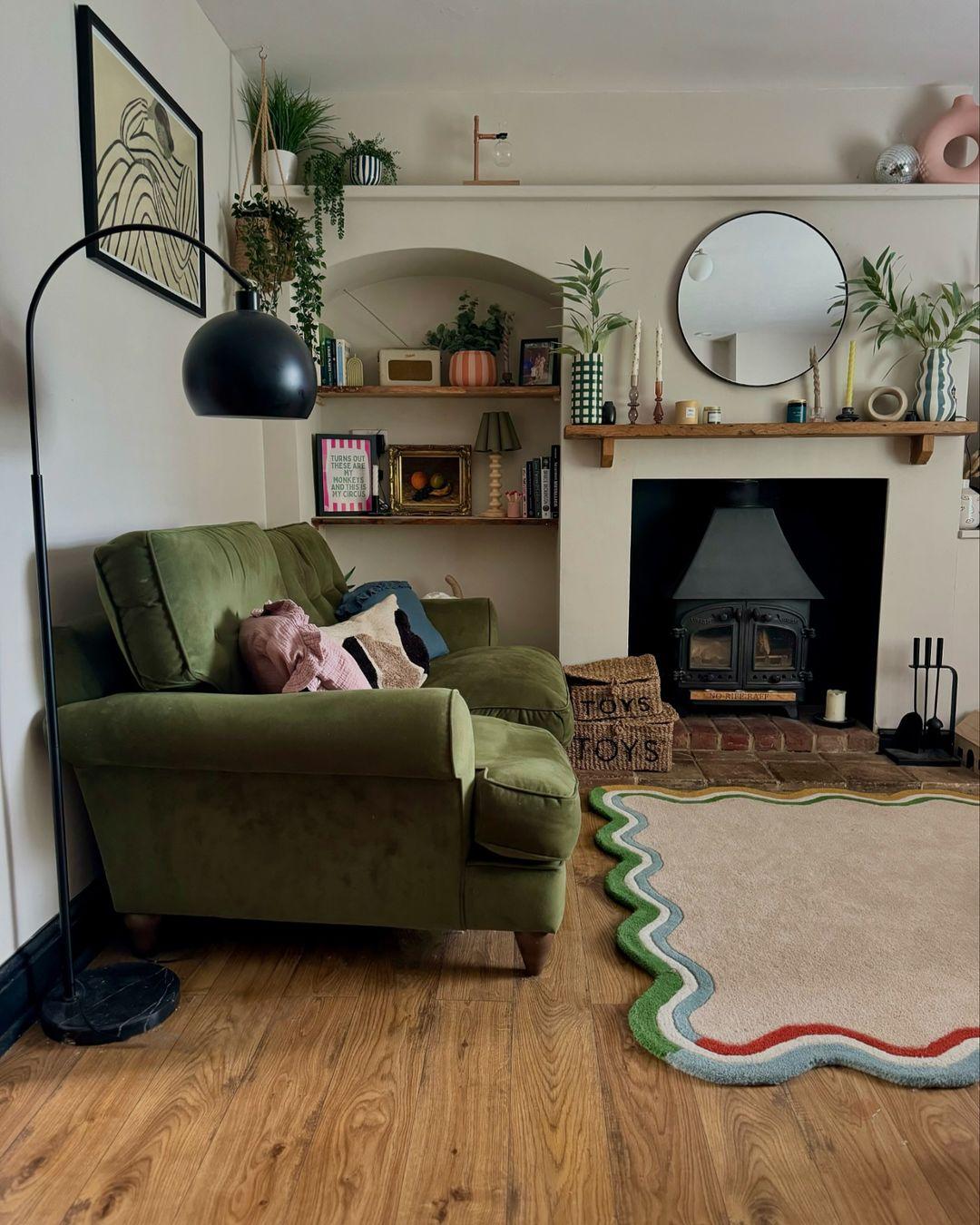 Image by thegreenwoldgaff
Image by thegreenwoldgaff
Jillee from One Good Thing by Jillee advises vacuuming around the burner and vent areas to clear dust and improve air circulation.
Read – 25 Most Beautiful And Lovely Coastal fireplace Ideas You Will Love
7. Check and Clean the Burner Ports and Pilot Light
Dust can easily gather around the burner ports and pilot light, and that can affect how well the gas flows and ignites. A little blast of compressed air can help clear it out. This is one of those small tasks that people often overlook, but it’s critical to the overall performance of your fireplace.
A dirty pilot light or burner means uneven flames, and nobody wants a fireplace that doesn’t light consistently when you need it most.
 Image by homeonthehey
Image by homeonthehey
8. Inspect the Venting System
Your fireplace’s venting system is like its lungs. If it’s blocked or obstructed, it won’t be able to “breathe” properly, leading to poor performance and, in some cases, dangerous carbon monoxide buildup.
Go outside and check the vent cap for leaves, snow, or other blockages. Proper venting ensures not only the fireplace’s efficiency but your safety as well. A blocked vent could mean that harmful gases, like carbon monoxide, are staying inside your home.
 Image by parrismckennadesign
Image by parrismckennadesign
Katie Berry from Housewife How-Tos advises checking the ventilation system during routine cleaning. A blocked vent can lead to dangerous carbon monoxide buildup, so she recommends inspecting the external vent for any obstructions like leaves or snow.
9. Clean the Exterior for Longevity
Wiping down the exterior isn’t just about keeping things looking nice—it’s also a way to protect the materials around your fireplace. Dust, grime, and fingerprints can wear down the finish over time.
Using mild soap and water ensures that you’re not stripping any protective coatings or scratching the surface. A clean exterior keeps your fireplace looking new and prevents long-term damage.

Image by houseliftdesign
Read – 15 Rustic And Timeless Candles In Fireplace Ideas You Will Love
10. Reassemble and Test It
Once you’ve cleaned everything, carefully put the logs and glass back in place. This isn’t just about looks—it’s about making sure your fireplace is ready to perform its best. Turn the gas back on and test the flames.
If you see flickering, uneven flames, or hear strange noises, those are early signs something might need further inspection. Testing the fireplace after cleaning ensures everything is working correctly before the colder months hit.
 Image by mmlighting
Image by mmlighting
11. Regular Professional Maintenance
While regular DIY cleaning is important, having a professional check your fireplace annually is a smart move. They can inspect things you might not notice, like gas leaks or wear on critical components.
An expert can also make any necessary adjustments to ensure everything runs safely and efficiently. Think of it as an annual health check-up for your fireplace, making sure it’s in top shape for the long run.
 Image by sunnycirclestudio
Image by sunnycirclestudio
Read – 25 Beautiful Limewash Brick Fireplace Ideas You Will Love
Extra Insights:
- Keep an eye on unusual smells: If you notice any odd odors, especially gas, turn off the fireplace and get it inspected right away. Strange smells can indicate a potential problem with the gas line or venting system.
- Carbon monoxide detectors are a must: Gas fireplaces, though efficient, can pose a risk if they aren’t venting properly. Installing a carbon monoxide detector near the fireplace ensures you catch any issues early.
- Cleaning regularly saves you money: Regular cleaning not only keeps your fireplace looking great but can also prevent costly repairs down the road. A clean, well-maintained fireplace runs more efficiently, using less gas and putting out more heat.
 Image by serenaandlily
Image by serenaandlily
Read – 30 Cozy Brick Fireplace Mantle Ideas You Will Love
By taking these steps, you’re not just cleaning your fireplace—you’re investing in its long-term performance and safety. Regular maintenance means fewer problems later, and when winter comes, you’ll be able to enjoy the warmth without any worries.

